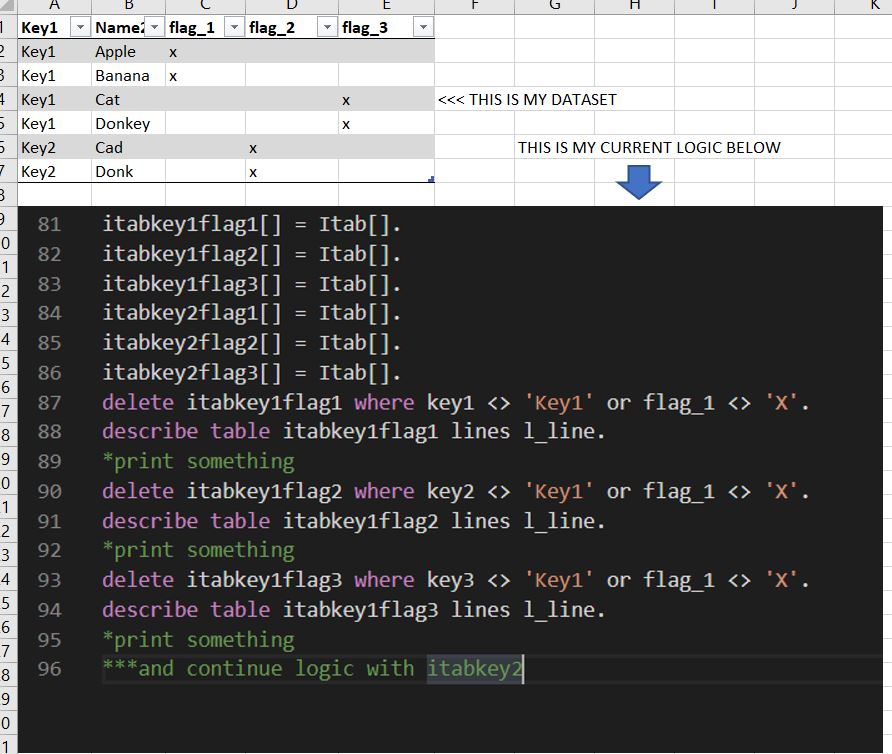- SAP Community
- Groups
- Interest Groups
- Application Development
- Discussions
- Re: Count from an internal table where flag = 'X' ...
- Subscribe to RSS Feed
- Mark Topic as New
- Mark Topic as Read
- Float this Topic for Current User
- Bookmark
- Subscribe
- Mute
- Printer Friendly Page
Count from an internal table where flag = 'X' (in 7.4 netweaver above)
- Mark as New
- Bookmark
- Subscribe
- Mute
- Subscribe to RSS Feed
- Permalink
- Report Inappropriate Content
05-18-2020 1:18 PM

Hi Experts,
is it possible to improve my logic(7.4 above alternative) so that we have lesser lines yet the same results?
i also consider LOOPING into ITAB and adding counter logic
but i'm thinking if is it possible to have one line logic for counting
eg. describle table itab where key = 'Key1' and flag1 = 'X' lines Key1Flag1count.
describle table itab where key = 'Key1' and flag2 = 'X' lines Key1Flag2count.
result should be:
Key1Flag1count = 2
Key1Flag2count = 0
Key1Flag3count = 2
Key2Flag1count = 0
Key2Flag2count = 2
Key2Flag3count = 0
- SAP Managed Tags:
- ABAP Development
- Mark as New
- Bookmark
- Subscribe
- Mute
- Subscribe to RSS Feed
- Permalink
- Report Inappropriate Content
05-18-2020 3:37 PM
Hi mchua9,
As you said you are working on 7.40 then REDUCE statement can come for rescue.
data(lv_lines) = REDUCE i( init x = 0 for wa in itab where ( key1 = 'Key1' or key2 = 'Key2' ..... ) next x = x + 1 ).Regards,
Anmol
- SAP Managed Tags:
- ABAP Development
- Mark as New
- Bookmark
- Subscribe
- Mute
- Subscribe to RSS Feed
- Permalink
- Report Inappropriate Content
05-18-2020 1:23 PM
Check FILTER statement
https://blogs.sap.com/2014/10/06/abap-news-for-740-sp08-more-for-internal-tables/
- SAP Managed Tags:
- ABAP Development
- Mark as New
- Bookmark
- Subscribe
- Mute
- Subscribe to RSS Feed
- Permalink
- Report Inappropriate Content
05-18-2020 1:29 PM
Hi mchua9
I would go with a LOOP statement, because you want to have a count of records for different conditions. This way you will only LOOP once through the table and count all necessary records in one go.
Regards,Mateusz
- SAP Managed Tags:
- ABAP Development
- Mark as New
- Bookmark
- Subscribe
- Mute
- Subscribe to RSS Feed
- Permalink
- Report Inappropriate Content
05-18-2020 1:53 PM
- Mark as New
- Bookmark
- Subscribe
- Mute
- Subscribe to RSS Feed
- Permalink
- Report Inappropriate Content
05-18-2020 3:37 PM
Hi mchua9,
As you said you are working on 7.40 then REDUCE statement can come for rescue.
data(lv_lines) = REDUCE i( init x = 0 for wa in itab where ( key1 = 'Key1' or key2 = 'Key2' ..... ) next x = x + 1 ).Regards,
Anmol
- SAP Managed Tags:
- ABAP Development
- Mark as New
- Bookmark
- Subscribe
- Mute
- Subscribe to RSS Feed
- Permalink
- Report Inappropriate Content
05-19-2020 9:35 AM
FILTER statement is also similar with transferring and deleting internal tables, which is great
but REDUCE statement gets the requirement done in just a single line! thank you for this answer!
- SAP Managed Tags:
- ABAP Development
- Mark as New
- Bookmark
- Subscribe
- Mute
- Subscribe to RSS Feed
- Permalink
- Report Inappropriate Content
03-25-2022 1:40 PM
Hi Anmol,
I had a similar requirement where I had to simulate the COUNT feature of SELECT syntax over an INTERNAL Table.
And your response helped me in achieving the same, just attaching the sample code snippet for others with similar requirements.

Thanks,
Sijin
- SAP Managed Tags:
- ABAP Development